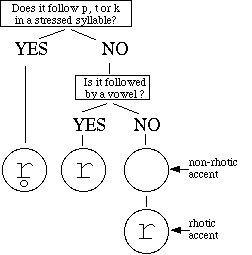There are many different types of r in the world's languages - even in such a small area as Europe:
The commonest English r, nearly everywhere except in Scotland, is a frictionless approximant, especially at the beginning of words.
(There is often some lip-rounding, and English people who cannot pronounce r sometimes substitute w. - In Icelandic they substitute the fricative g-sound in 'saga' - so-called 'gormæli'.)
Before going on to the next section, you'll need to look at the page on
 rhotic and non-rhotic accents
rhotic and non-rhotic accents
 Allophones of r
Allophones of r
You'll remember that the term allophone is used for the different pronunciations of a phoneme according to the sounds around it. At this point you should refresh your memory on the flowchart we drew up to explain the allophones of l (here's a link to it  )
)
as you might have guessed, we can show the allophones of r with a similar flowchart:

We have almost the same rules as with l:
 Linking r
Linking r
In non-rhotic accents, then, there's no r at the end of words.
But r can appear at the end of words if the next word begins with a vowel:
But this isn't as simple as it looks. Why does the r appear before a vowel in the next word? Is it simply because there's an r there in the spelling? Hardly - children who can't read, and know nothing about r's in spelling, also use it at the end of words like 'here' and 'doctor'. So how do they know?
This question needs a page to itself .... 
![]() rhotic and non-rhotic accents
rhotic and non-rhotic accents